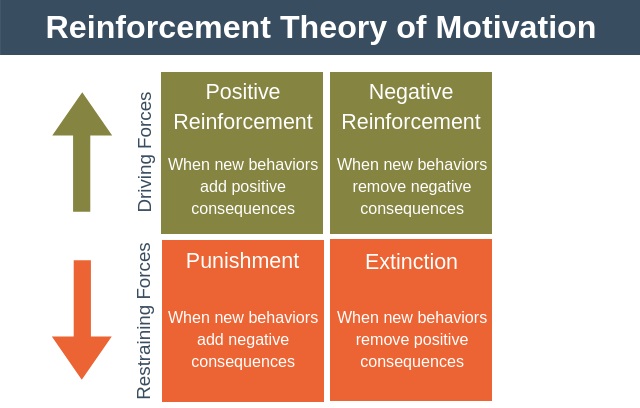
HR Guide: Motivating Employees Using Reinforcement Theory
Are You Hiring?
Find candidates in 72 Hours with 5+ million talents in Maukerja Malaysia & Ricebowl using Instant Job Ads.
HIRE NOW
The reinforcement theory states that an employer can influence and change the behaviour of employees through reinforcement, punishment, or extinction.
The employees who exhibit desirable behaviours in the company should be rewarded, whereas employees who exhibit undesirable behaviours should be imposed with suitable punishment so such behaviours can be prevented in the future.
Extinction is done in order to stop a learned behaviour from continuing in the workplace. When a manager applies reinforcement, punishment, or extinction, the process is referred to as operant condition.
Two types of reinforcement
Positive reinforcement
This type of reinforcement happens when an employer gives a positive response to an employee's behaviour that is likely to impact the organisation as well. For instance, if an employee comes in early to work on an important project, praising them for putting in more time towards the project is a form of positive reinforcement.
Positive reinforcement also includes rewarding an employee with a bonus or compensation. This type of reinforcement is likely to encourage employees to keep practising the desired behaviour. Employees are more likely to be receptive to change when they are positively reinforced for a job well done by the management.
Negative reinforcement
Negative reinforcement is used to motivate employees to behave how in a desirable manner so they will not have to suffer the negative consequences of not doing so. If the employee behaves accordingly, the negative result will be withheld.
For instance, an employee fails to meet their deadline. As a manager, you can instruct them to provide you with daily reports on their progress towards meeting the deadline. The employee will not like to do that so they are likely to change their behaviour so they will always meet the required deadlines.
Once the employee demonstrates that they can consistently deliver on time, you can stop requesting for the daily reports. This is what negative reinforcement is all about.

Source: Expert Program Management
Punishment
Punishment happens when an employer imposes a negative consequence to stop or reduce undesirable behaviours at the workplace. For instance, employees who don't come to work on time will be given a warning. This warning serves as a punishment to discourage employees from being late.
The difference between punishment and negative reinforcement: negative reinforcement withholds a negative consequence to encourage behaviour while punishment imposes a negative consequence to discourage undesirable behaviour.
A threat of punishment can be given in negative reinforcement but it should not be followed through once an employee performs positively.
Extinction
Extinction will bring an end to a behaviour that the employee has learned over a given period of time. For example, during a busy period, a manager may decide to provide some positive reinforcement in the form of overtime pay to encourage employees to work extra hours and work during the weekends.
When the business finally slows down, the manager will stop approving the overtime pay as a move to dissuade employees from working extra hours and weekends. The behaviour will be forgotten after some time because the positive reinforcement is no longer there.
Employers should be careful when doing this as employees who no longer receive positive reinforcement usually feel unappreciated and their morale and productivity could go down, negatively affecting your business.
Schedules of reinforcement
In order for the reinforcement theory to be effective, a schedule of reinforcement is necessary as it shows when and how positive or negative reinforcement should be provided. The schedule can be:
1. Continuous Reinforcement: This happens every time an employee demonstrates the desired behaviour.
2. Intermittent Reinforcement: Since a manager is not always available to offer reinforcement for desired behaviours, this type of schedule is used in many organisations. It can be done in four ways:
-
2.1 Fixed-Interval Schedule: The reinforcement is given in between fixed time periods such as a biweekly paycheck.
-
2.2 Variable Interval Schedule: Reinforcement is given at different times and no schedule is followed. For example, a manager praising an employee every time they come in early.
-
2.3 Variable-Ratio Schedule: Reinforcement is given after a set number of desired behaviours is achieved. A great way to achieve this is by providing a bonus as a positive reinforcement when all the desired behaviours are achieved.
-
2.4 Fixed ratio schedule: Reinforcement is given when a fixed number of actions have been performed. For example, an employee is rewarded if they make 10 sales in one day.

Clarity is of the utmost importance when it comes to reinforcement.
How to use the model
1. Specify desired behaviour
Tell the employee what is expected of them. Do this in as clear and objective terms as you can.
Describe the good behaviour you want to see or the bad behaviour you want to discourage, in a way that it can be measured. It’s also recommended to put a deadline in place so that the employee knows the timeframe they have in which to change.
2. Measure current desired behaviour
The next step is to baseline how often the behaviour in question happens currently. Unless the starting point is measured, it will be difficult to objectively evaluate if a behaviour has changed or improved.
3. Reinforce desired behaviour
Tthe manager needs to determine how and when they will reinforce the new behaviour.
First, the manager will need to choose one or more of the four types of reinforcement: positive reinforcement, negative reinforcement, punishment, and extinction.
Second, they will need to select one or more schedules of how they will reinforce the behaviour: continuous or intermittent.
4. Evaluate change
The final step is to measure if the new desired behaviour is increasing in frequency quickly enough. If it is, great. But if it isn’t, then the manager may need to reassess their approach and work through steps 1 to 4 again.
For employers, the reinforcement theory is an effective tool to encourage higher productivity among employees. This theory is also useful in making of star performers and correcting the behaviours of poor performers.
Are You Short on Staff? Reach four millions of job seekers on Maukerja, Ricebowl, LinkedIn, Jora, Trovit, and more when you post a job on AJobThing.com
Post a job today!
Sources: Management Study HQ & Expert Program Management
Related article
5 Interview Questions You Should Not Ask
HR Guide: Job Analysis and Its Methods
How to Identify a Disengaged Employee

